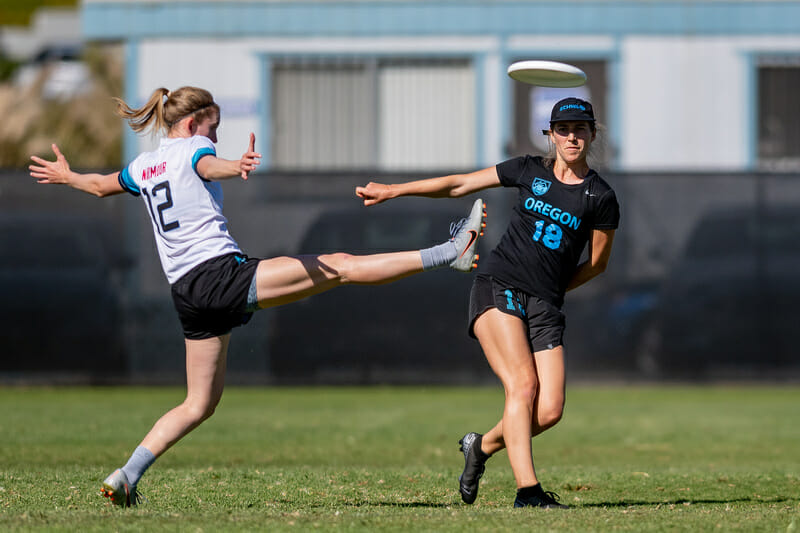Spacing and timing made Schwa's offense dynamic and dangerous.
December 10, 2019 by Sion "Brummie" Scone in Analysis with 0 comments

Portland Schwa came into the USA Ultimate National Championships seeded 9th and went 1-2 in pool play before catching fire in the bracket and eliminating two higher seeds in pre-quarters (Vancouver Traffic, who had beaten them at Northwest Regionals) and quarters (Denver Molly Brown) to break into the semifinals.
Let’s take a look at some principles of their offense from those two games that helped deliver their best Nationals result in years.
Handler-Driven Play
Schwa’s handler movement proved difficult for their opponents to shut down.
Watch this classic handler weave; it works by having multiple throwing options, one on either side of the mark. As a marker, it’s hard to know what to do here: if you commit to stopping the around, then you open yourself up to a give-and-go to the open side. Commit to stopping the inside break, and you leave a huge amount of space on the break side for a thrower to exploit.
Without a doubt, though, it’s the inside break that Schwa favored. Below we have a great example of that handler weave movement using almost exclusively the “chisel” cut, one that starts level with the disc and goes 45 degrees upfield towards the disc. The idea is that the disc only has to be thrown a short distance to the open side to hit the receiver, whose momentum will then take them onto the break side from where they can hit continuation. It’s a move you’re going to see a lot of here:
As a defender, if you overplay the chisel cut, then you just open the door for the receiver to “wrinkle” back towards the open side, as perfectly demonstrated here by Laura Bitterman, who leaves her defender in the dirt:
Traffic tried all kinds of things to stop them, including some three-way poaching, but Schwa just weren’t phased at all:
It wasn’t just handler movement where Schwa look to use the inside channel. Look at this: one, two, three inside breaks in a row, ending with a beautiful leading pass for the goal.
Another example: the first pass is a looping around break (because the marker has committed to stopping the inside throw), and when the next marker commits hard to stopping the continuation, it just opens up the inside break lane. Schwa hit continuation and then some fancy footwork from Bitterman leaves another defender on the floor:
Deep Attack
Despite all this phenomenal handler movement, I wouldn’t want to leave the impression that Schwa is one-dimensional. Far from it. They employed a number of really effective pull plays and had no hesitation throwing deep.
This is a simple example from side stack — Eva Popp to the speedy Kimber Coles:
Below we get a good look at the timing involved in deep cutting. Watch the cutter who catches the huck, Brenna Bailey, as she slowly moves clear of the handler space, waiting for the perfect moment to cut deep, which comes as the disc moves to Emery Otopalik:
Molly Brown might have messed up their defensive coverage on this play, but it doesn’t really matter — the cutting pattern is sufficient to illustrate the effectiveness of cutting in conjunction with a teammate. One goes under, one goes deep, a classic “peppermill” move:
And an almost carbon copy here. It shouldn’t come as a surprise to see that it’s the same receiver on both clips, Kristen Rosenblum:
I like this clip because it really shows you how a team can grind away while still constantly looking for deep shots. The pull play is fielded using a side stack, very similar to the first huck clip above, and you can see deep cuts made almost every time the disc moves. The only thing stopping the throw is the decision making of the thrower. Schwa is really patient until they get a situation they like.
To play this kind of aggressive hucking style, you have to be confident, both in your throws and your receivers, and this is really summed up by the final clip. After winning the disc back in their own end zone, Schwa is quick to offer deep cuts, hit a big deep cut from a handler position, then immediately dump and set off for the end zone.
Just to highlight something: Maddie Franz is behind the disc at the start of this clip, runs past the entire field, skies once, resets, then goes long again for the goal. If that isn’t the definition of aggressive and confident cutting, I don’t know what is.
Conclusion
The combination of break throwing and short game from the Schwa handlers paired with a varied deep attack both from the pull and in flow, including from the handler position, made them a difficult team to stop. Their big 15-8 loss in semis to Toronto 6ixers reflects at least in part a matchup problem: 6ixers is one of the more athletic teams in the division. Defensive speed can really stifle a deep game.
Despite that loss, Schwa capped off their best season in years with a top four finish and a Pro Flight qualification for the 2020 season.